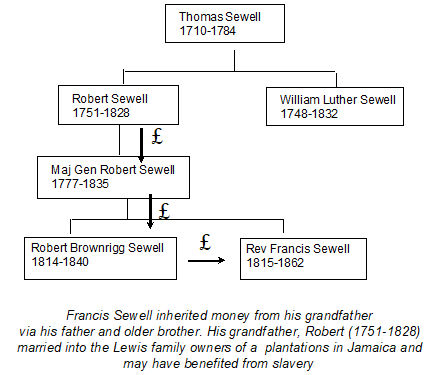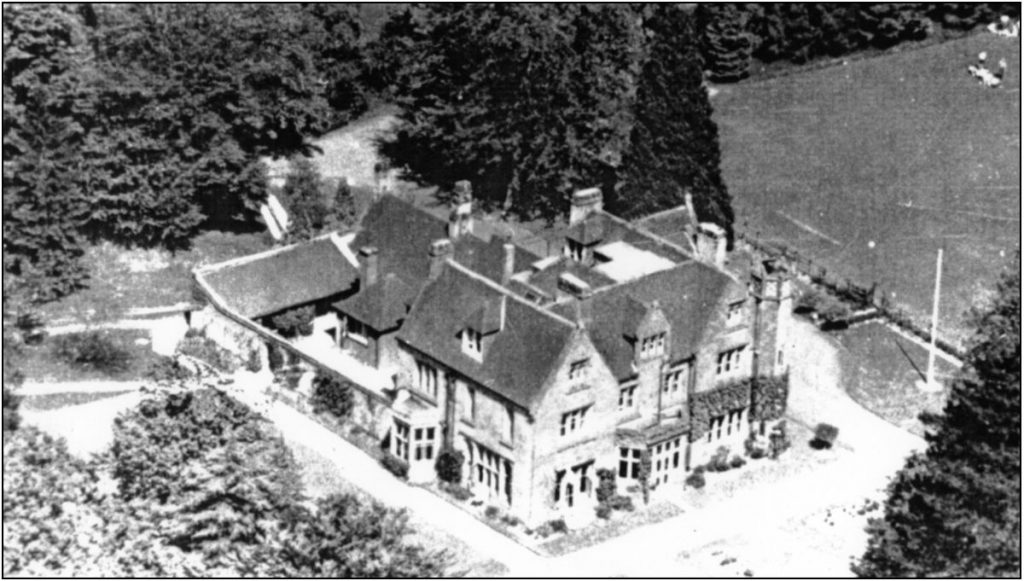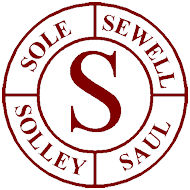By Richard Bryant
This article was published in the August 2019 edition of Soul Search, the Journal of The Sole Society
This is the final instalment of an article based on a paper by the Lindfield History Project Group and we are grateful for their permission to print it. Here is described the building of the Rectory, other properties he owned, his will and his possible connections with slavery.
RECTORY HOUSE, THE WELKIN
The Rectory House, subsequently named The Welkin, meaning Vault of Heaven, was built on land to the rear and west of High Street. Much of this land came into Sewell’s possession as a result of his purchase of Townlands Farm.
The foundation stone was laid by the Bishop of Chichester on 13 May 1856 and, in Sewell’s speech at the ceremony, he said ‘his Lordship had led him to suppose that the sum of £1,500 would not be a large sum for a Rectory House. The one proposed would cost £3,000, of which sum he would present one-half. It would be the residence of all future minsters, if worth accepting, otherwise it must return to his own family’. The Bishop responded with a speech of thanks and support.
The house built was completed at the end of 1856 or shortly after and was a large Gothic style house built of stone, set in extensive grounds, approached by a lengthy carriage drive running from the High Street directly opposite the church, alongside the southern boundary of Townlands.
Lindfield Vestry records state ‘A valuation has been taken this tenth day of November 1857 by Order of the Vestry held on the 5th day of November 1857, viz The House newly erected on a part of Town Lands containing two acres of the land, put out in plantations and held by the Revd F H Sewell: Gross Estimated Rental £90. Rateable Value £60.’ At the same meeting the ‘Cottages detached from the school be at the sum of £9 Gross Estimated Rental, Rateable Value £6’.
In 1861, Sewell applied to the Lindfield Parish Vestry meeting for the permanent and ‘entire stopping up’ of a footpath or track from ‘Lindfield Town’ which ran across his grounds. The Vestry meeting, by a majority vote, refused to close the footpath.
Following Sewell’s death, the property was put up for sale by auction in September 1863. The house was described in the auction advertisement as ‘containing principal and secondary bed chambers and dressing rooms, water-closet, porch entrance leading to a spacious entrance hall and wide stone staircase, back stair case, suite of reception rooms 12ft 6 high, with southern aspect, consisting of drawing room 23ft 6 by 15ft 9, dining room 22ft by 16ft 6, morning room, study, lavatory, water closet, complete servants’ offices’. The grounds comprised ‘beautiful lawns, pleasant and productive gardens and meadow land, the whole containing 21a 1r 6p and possessing a considerable building frontage. ’
After Sewell’s death, a Mr Griffiths purchased and occupied the house and ‘16 acres’. Thus Sewell’s wish to provide a rectory house for future incumbents did not come to fruition.
In the absence of a rectory for the parish, Sewell’s replacement, Rev F Mills, had to rent Townlands and for a time became homeless, moving his family into the old National School building on the Common.
PROPERTIES NOT IN LINDFIELD PARISH
William Luther Sewell, the son of the Right Hon Sir Thomas Sewell, acquired the Twyford estate in 1787. Twyford, some six miles north east of Lindfield, is situated in the northern corner of Maresfield Parish close to the East Grinstead and West Hoathly parish boundaries.
On William Luther Sewell’s death, the estate passed to his nephew, Major General Robert Sewell. And his estate being inherited by his eldest son, Robert Brownrigg Sewell.
Robert Brownrigg Sewell died on 5 July 1840 and in accordance with the will, Rev Francis Sewell, his brother came in possession of the estate, including land in the parishes of Maresfield, East Grinstead and West Hoathly. Presumably this was part of the ‘moderate fortune’ mentioned in Francis Sewell’s obituary.
It is believed Francis Sewell mortgaged part or all of the estate in 1848 to Sir Henry Lushington, whose wife Frances Maria Lushington (nee Lewis), was Sir Thomas Sewell’s granddaughter.
In a Codicil dated October 1850 to Francis Sewell’s Will of 2 August 1849, reference is made to ‘Cottages, Lands, Tenements and Hereditaments situated within and holden of the Manors of Maresfield and Duddleswell in the County of Sussex, which I some time since purchased from Charles William Thomas Tyndale, Esquire’. The location of these properties is not known, but were in addition to those recorded in the Tithe surveys.

FRANCIS HILL SEWELL’S WILL, INHERITANCES AND CHANCERY
Francis Sewell’s Will dated 2 August 1849, described him as ‘now of Cockerham’ is not straightforward to interpret. It opened with a reference to a marriage settlement dated 16 July 1841, followed by an entitlement ‘in my own right under the Will of my late Father immediately expectant on the decease of my Mother Eliza Sewell’, and by an entitlement as ‘one of the next of Kin of my Brother Robert Brownrigg Sewell deceased of and in several Sums of Twenty eight thousand, four hundred and seven pounds eighteen shillings and five pence, three per cent consolidated Bank Annuities and Five thousand four hundred and sixty eight pounds and fifteen shillings – five pounds per cent India Book Debt were limited unto the said Alfred Chapman Hastings Dent and Thomas Allen Dent’ (named in the third part of the marriage settlement).
Reference is then made to ‘the life interest of the said Julia Sewell’ and the action should there be no children. Finally he ‘also Give and Bequeath unto my said Wife the whole of my personal estate and Effects of whatever it may consist …’
The Will had a Codicil dated October 1850 added which related to cottages and land purchased from a Charles Tyndale in the Manors of Maresfield and Duddleswell.
There were no codicils mentioning the Lindfield tithes, school or rectory house, which his pronouncements indicated an intention to convey to the parish in the event of certain payments being meet.
Robert Trotter of Twyford Lodge and Julia Sewell were named as executors. Probate was granted on 15 December 1862 with the estate being valued at £1,500.
Arising from the case Harrison v Trotter in Chancery, mentioned previously, the defendants, Robert Trotter, Julia Sewell and Robert Sadleir were required to put the Lindfield properties up for sale in September 1863.
In 1863, Letters of Administration were granted to Robert Trotter in respect of Letitia Sarah Sewell’s (died 21 January 1847) estate left unadministered by Rev Francis Sewell, also for Robert Brownrigg Sewell (died 4 June 1840) whose estate had been left unadministered by Mrs Eliza Serena Sewell, his mother. As the estate of Robert Brownrigg Sewell was left unadministered by Mrs Eliza Sewell, it raises the question whether Francis Sewell legally benefited from his brother’s estate. Did he just use the assets without proper legal title?
THE SEWELL FAMILY AND SLAVERY
In the 18th and early 19th centuries it was not uncommon for wealthy families to be connected with slavery. The Legacies of British Slave-ownership project conducted by University College London shows the members of the Sewell family supported and benefited from slave ownership and Jamaican sugar plantations.
Frances grandfather Robert Sewell (1751–1828), married Sarah Lewis in 1775, the daughter of William and Jane Lewis (nee Gregory), owners of plantations in Jamaica. Robert was appointed Attorney General of Jamaica in 1780 until 1795 and, on returning to England, was the Agent for Jamaica from 1795 to 1806. At the 1796 General Election he was returned as the MP for Grampound until 1802.
Having married into the slave owning Lewis family, it is possible he might have benefited financially from slavery, but regardless of any direct involvement Robert was a strong supporter of slavery. As an MP, in 1797 during a parliamentary debate on slave abolition, he said the trade could not cease until the islands were fully cultivated. In a debate on 3 April 1798, he spoke of the necessity for compensation for the planters if abolition was introduced. On 30 April 1798 he opposed a motion to prevent the crowding of small ships with slaves, and again opposed abolition on 4 May 1798. Six days later, he criticised the slave carrying bill and the proposal that a slave needed 40 cubic feet of space in a ship. Robert Sewell expressed the view that negroes preferred to be herded together and that six and a half feet were ‘more than sufficient’.
When Robert Sewell (1751–1828) died his beneficiary was Major General Robert Sewell (1777–1835). On the latter’s death, benefits passed to his eldest son, Robert Brownrigg Sewell (1813–1840), then following his death to the next eldest son, namely Francis Sewell. Accordingly, it is possible that the entitlements due to Francis Sewell could have contained money initially derived from slavery.
Within the extended Sewell family, Matthew Gregory Lewis novelist and MP for Hindon 1796-1802, (also known as ‘Monk’ Lewis on account of his Gothic novel The Monk), inherited estates and over 400 slaves in Jamaica as tenant-in-tail.
However, it should be noted that Matthew Gregory Lewis was an advocate of improving the condition of slaves and enforced changes on his estates. On one of his visits to his Jamaican estates, Lewis wrote to William Wilberforce asking whether he should free the enslaved on his estate, having previously assigned them to Wilberforce’s care after his death. On his death he left the Hordley and Cornwall plantation estates to his sisters, Fanny Maria Lushington and Sophia Elizabeth Shedden.
Indicative of close family relationships, Dame Fanny Maria Lushington’s husband, Sir Henry Lushington, provided a mortgage to Francis Sewell in respect of property at Twyford, although there is no evidence this money originated from slavery. Likewise there is nothing to directly link Francis Sewell with the slave trade, although his extended family supported and benefited from slavery.
CONCLUSION
Born to a high achieving military family with impressive antecedents, Francis Sewell chose the life of a parish priest. There is little doubt that he was a sincere Christian and Churchman, with a desire to do good, so typical of Victorian times. However, despite his desire to minister to the parish, Sewell considered it appropriate to depart the village for nine years. The reason for his departure is not known: he was not without money, so if for financial benefit this would be a questionable decision. Despite being absent from Lindfield he remained the incumbent and closely involved in parish church related matters.
During his initial period in Lindfield, he put in hand restoration work on the church, albeit at the expense of destroying many old features. He gave a not insignificant sum of money to the project with the expectation that the parishioners would contribute the much larger sum required to complete the funding. Sadly, the money was not forthcoming and the parish church was left with a debt for several years.
He was involved with the National School for the education of the poor, which in 1851 moved to a new school room on the Common, on land donated by the Earl of Chichester.
While away in Cockerham during the mid 1850s, Sewell initiated his master plan to purchase the tithes, build a new school to replace the National School established five years previously and build a large rectory house as his residence. In all these endeavours, Sewell made a donation to launch the projects; and for the building projects provided the funding, while retaining ownership until contributions reached his required amount by a specific date. Sewell made much of his wish not to benefit personally. The required money was not received and none of the properties was conveyed to the parish.
His agreement and expectation to purchase the Lindfield tithes, worth about £600 per annum, appears to have triggered his planned return to Lindfield. Again his plan was to sell the tithes to the parish, albeit at a discounted rate. However, the restitution of the tithes had not been achieved by the time of his death.
All the main elements of Sewell’s Brief Statement had one feature in common in that he appears to have acted unilaterally without consultation while expecting others to pay if the benefits were to transfer to the parish.
From the published list of contributors there is no evidence that they rushed to answer his appeals. Perhaps he was not held in high regard due to his leaving the parish or perhaps his good works were perceived as vanity projects to enhance his status. The reasons why contributions were not forthcoming will never be known. Whatever the reason his plans failed.
Returning to Lindfield in 1858, Sewell resided at The Welkin until his early death after a short illness in October 1862.

An aerial view of The Welkin, which Sewell had hoped would remain as the rectory after his death
Immediately following his death, the St John’s School closed and it was not until 1863 that the National School reopened in its original building, but failed to thrive and soon closed. The other Lindfield properties and land owned by Sewell were put up for sale in 1863.
Francis Sewell’s vision of lasting benevolence to the parish came to nothing. Nevertheless, he can be credited with putting in hand projects with good intentions and establishing regular church services in the parish church. Credit can also be claimed for introducing gas to Lindfield.
Today the elegant stone built master’s house remains as St John’s Lodge, and the school building exists as private dwellings. The Welkin name lives on as a large 1970s housing development in the grounds of the demolished rectory house. Sadly, there is no trace of his name in the parish church he saved and few in the village today would recognise his name.
